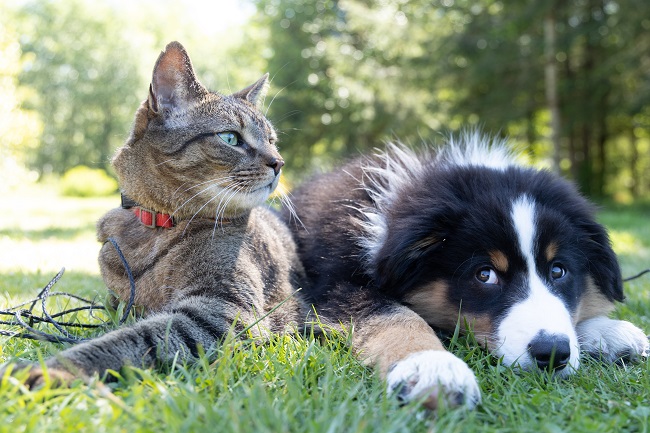
Getting or adopting new pet can be such a fun and exciting experience, but if you already have one, you need to be careful. When introducing a new pet to an existing pet, it is essential to have expectations that are based on reality.
This article lists the six things to keep in mind when you introduce a cat to a dog.
Step 1 – Get Both Your Dog and Cat Fully Vaccinated
Keep them apart for at least three to four days. Avoid introducing your new cat to the dog until she has been examined by a veterinarian and declared healthy. Place your new pet in a closed sanctuary room or on a separate floor of your home. The objective is to let the pets get used to each other’s presence without having to interact face-to-face. They can hear and smell each other even though they cannot see each other.
Step 2 – For the Initial Few Days, Keep the Animals in Separate Rooms
By separating the dog and cat from one another, you can begin the process slowly. You might want to think about locking the cat in a bedroom for a few days while everyone adjusts if both animals are only kept indoors. If you keep the cat separate in a bedroom, make sure to include a litter box, toys, food, and water for it as well. It is best to keep the dog out of the house or locked up when you first bring the cat into the house.
Step 3 – Introducing Dog Puppies and Kittens
Dogs with a strong prey drive may be extremely excited by a kitten’s movements due to their small size and desire to run and play. Even if your dog gets along well with your adult cats, keeping a close eye on her when she’s with a kitten is critical. If your dog is young and active, she may attempt to play with the kitten and injure or kill it.
Therefore, when you are not watching them, keep dogs and kittens apart for your own safety. Because a well-socialized adult cat might be fine with puppy acting like a puppy, it can sometimes be easy to introduce adult cats to puppies.
However, it is up to you to intervene if your boisterous puppy is chasing your timid cat. You will want to control their interactions until the puppy is old enough to have more self-control and has received some training. Your puppy shouldn’t be taught that it’s fun to chase the cat. The animals can be separated safely and comfortably by using baby gates. You can also put your puppy on a leash to help you keep an eye on her. If she starts to chase the cat in this way, you will be able to easily redirect her away from it.
Step 4 – Meeting That are Fearful or Aggressive Should be Avoided
Avoid any interactions between your pets that are fearful or aggressive. It can be challenging to alter these responses if they are allowed to become routine. It is preferable to gradually introduce your pets to one another so that neither one becomes fearful or aggressive.
These behaviors may manifest in mild forms, but you should avoid allowing them to become more severe. If either animal exhibits fear or aggression, you should separate them and begin the introduction process all over again in very small, gradual steps, as described above.
Step 5 – Face-to-Face Introduction
This type of introduction is more rapid-fire. One person should observe the dog’s body language while holding the dog on a loose lead. The cat’s body language should be watched by someone else.
If the cat is not hissing or raising his back toward the dog, he can move around freely. Although cats rarely pose a threat to dogs, some cats will become aggressive when they meet them. You can ask the dog to sit or lie down and stay if she has been taught those cues. If the dog is calm around the cat, you can let the cat move around freely and let the cat sniff the dog if he wants to. If the dog ignores the cat, she should be praised and rewarded.
Step 6 – For the First Few Encounters, Leave the Cat Alone and Confine the Dog to its Crate
Put your dog in its kennel and lock the door while the cat is in the other room. After that, let the cat out and encourage it to come with the dog into the room. The cat should eventually become interested in the dog and get close enough to smell it.
If your dog becomes agitated when it sees the cat, try speaking in a soothing voice to calm it down. Treats are given when the dog behaves in a manner that encourages calmness and uses positive reinforcement.
Related Articles & Free Email Newsletter Sign Up
How George Washington Returned a Dog to its Owner in the Middle of the Revolutionary War


Comment here